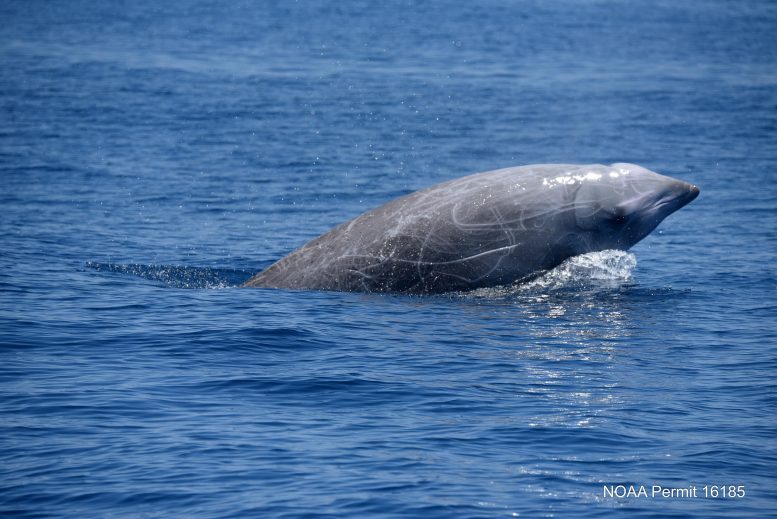
I can understand why you’d want to tell all your friends how you spent two minutes underwater after completing a month-long Wim Hof retreat, but no one’s a match for Cuvier’s beaked whale. According to the findings of a five-year survey that tracked many individuals across thousands of dives, one of the whales held its breath underwater for a mind-boggling three hours and 42 minutes.
Nature’s top scuba diver
Cuvier’s beaked whales, also known as goose-beaked whales (Ziphius cavirostris), are the champion divers among all mammals. Everything about them seems perfectly adapted for diving, from their super-streamlined bodies to the huge stores of myoglobin in their muscles, which helps them to hold more oxygen in their bodies.
Cuvier’s have a cone-shaped head, with a stubby beak and two throat grooves. They’re easily recognizable due to their short mouth-line that curves upwards, resembling a cheeky smile. Males have two teeth at the tip of the lower jaw, which protrude like small tusks in older males, while females don’t have any visible teeth.
Even before researchers at Duke University and the Cascadia Research Collective presented the findings of their five-year-long survey off the coast of Cape Hatteras, North Carolina, Cuvier’s already held the records for the longest and deepest dives — but these new reports are just ridiculous.
According to the study published in the Journal of Experimental Biology, one Cuvier’s wearing the tag TzTag066 stayed underwater for nearly three hours in 2017. One week later, TzTag066 outdid itself and held its breath underwater for three hours and 42 minutes.
This blew out of the water the researchers’ initial estimation of a Cuvier’s maximum dive time of 33 minutes before their oxygen runs out and they resort to anaerobic respiration. It took a while, though, before Nicola Quick and colleagues at Duke University were able to explore what these shy mammals are truly capable of.
“Because the animals spend so little time at the surface, we needed calm seas and experienced observers to look for them”, says Quick, adding, “the average period they spend at the surface is about 2 min, so getting a tag on takes a dedicated crew and a maneuverable vessel”.
The researchers were able to tag a total of 23 individuals from 2014 to 2018, during which time they recorded more than 3,600 dives. The shortest dive lasted just under 33 minutes while the median duration was clocked at 59 minutes.
Clocking all of these dives proved extremely challenging. Each time a whale surfaced, the researchers had a brief window of time during which they had to transfer information recorded by the tags to a satellite. Sometimes, the whales stayed at the surface for hours, but most of the time they only stayed for a couple of minutes before diving back to depths of up to 3,000 meters foraging for their favorite prey.
“It really did surprise us that these animals are able to go so far beyond what predictions suggest their diving limits should be”, says Quick.
“We didn’t believe it at first; these are mammals after all, and any mammal spending that long under water just seemed incredible,” he added.
Andreas Fahlman, a researcher at the Fundacion Oceanografic de la Comunitat Valencia in Spain and co-author of the study, suspects that the Cuvier’s must have an exceptionally low metabolism for them to be regularly able to exceed dives longer than 77 minutes. Additionally, the Spanish biologist believes the mammals have unusually large oxygen stores and an above-average ability of withstanding stinging lactic acid buildup in their muscles.
As for why the Cuvier’s tagged with TzTag066 stayed so exceptionally long underwater, Quick doesn’t have a definite answer. It may be that the animal found a particularly productive food patch. Alternatively, the whale may have perceived a threat and stayed longer than usual underwater to stay safe.
Cuvier’s are particularly vulnerable to noise pollution and active sonar signals employed by the U.S. Navy. Besides noise, Cuvier’s beaked whales are threatened by plastic pollution, bycatch, and active hunting in Japan and Indonesia.


